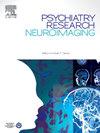Morphometric brain MRI findings in hair-pulling and skin-picking disorders in youth
IF 2.1
4区 医学
Q3 CLINICAL NEUROLOGY
引用次数: 0
Abstract
Pediatric hair-pulling disorder (HPD) and skin-picking disorder (SPD) are treatment-resistant conditions understudied with neuroimaging. We report cross-sectional morphometric MRI results from the adolescent-early adult subsample of the Body-Focused Precision Medicine Initiative (BPMI), a major HPD-SPD MRI database. Participants aged 11–21 years comprised 30 with HPD, 13 with SPD, 16 with both HPD and SPD, and 29 typically developing (TD). Whole-brain MRI was parcellated into cortical and subcortical regions with FreeSurfer. Volume and (for cortex) thickness and surface area of each region were analyzed for effects of HPD and SPD, controlling for psychotropic medication, age, total intracranial volume, and scanning site. Morphometry of four regions most reflected diagnosis and severity of HPD: 1) left inferior frontal cortex (larger and thicker for more severe HPD); 2) corpus callosum (larger for more severe HPD); 3) lingual gyrus (smaller right cortical surface area and white-matter volume); and 4) fusiform gyrus (smaller right cortical and white-matter volumes for more severe HPD). For SPD, there were three regions: 1) parahippocampal gyrus (larger left white matter volume and larger bilateral cortical volume and surface area for more severe SPD); 2) fusiform cortex (thicker left cortex for more severe skin-picking urgency); and 3) entorhinal cortex (thicker right cortex for more severe urgency). Variations in regional morphometry may result from or predispose to HPD and SPD. Left inferior frontal and callosal findings suggest lateralized dysfunction in HPD similar to language disorders; in SPD parahippocampal findings may indicate dysfunction in emotion regulation and/or contextual association.
青年拔毛和抠皮障碍的脑形态MRI表现
小儿拔毛障碍(HPD)和抠皮障碍(SPD)是治疗难治性疾病,神经影像学研究不足。我们报告了一个主要的HPD-SPD MRI数据库——以身体为中心的精确医学倡议(BPMI)的青少年-早期成人亚样本的横断面形态测量MRI结果。11-21岁的参与者中有30人患有HPD, 13人患有SPD, 16人患有HPD和SPD, 29人患有典型发展(TD)。用FreeSurfer对全脑MRI进行皮层和皮层下区分割。在控制精神药物、年龄、颅内总容积和扫描部位的情况下,分析HPD和SPD对各区域的影响,并分析各区域的体积、皮质厚度和表面积。最能反映HPD诊断和严重程度的四个区域的形态测定:1)左侧额叶下皮层(HPD越严重,越大,越厚);2)胼胝体(重度HPD越大);舌回(右侧皮质表面积和白质体积较小);4)梭状回(更严重的HPD患者右侧皮质和白质体积较小)。SPD有三个区域:1)海马旁回(SPD越严重,左侧白质体积越大,双侧皮质体积和表面积越大);2)梭状皮质(较厚的左皮质对于更严重的抠皮急迫性);3)内嗅皮层(更严重的急症右侧皮层较厚)。区域形态学的变化可能是由HPD和SPD引起的或易患的。左侧额下叶和胼胝体的发现表明HPD的侧化功能障碍类似于语言障碍;SPD海马旁区的发现可能表明情绪调节和/或情境关联功能障碍。
本文章由计算机程序翻译,如有差异,请以英文原文为准。
求助全文
约1分钟内获得全文
求助全文
来源期刊
CiteScore
3.80
自引率
0.00%
发文量
86
审稿时长
22.5 weeks
期刊介绍:
The Neuroimaging section of Psychiatry Research publishes manuscripts on positron emission tomography, magnetic resonance imaging, computerized electroencephalographic topography, regional cerebral blood flow, computed tomography, magnetoencephalography, autoradiography, post-mortem regional analyses, and other imaging techniques. Reports concerning results in psychiatric disorders, dementias, and the effects of behaviorial tasks and pharmacological treatments are featured. We also invite manuscripts on the methods of obtaining images and computer processing of the images themselves. Selected case reports are also published.

 求助内容:
求助内容: 应助结果提醒方式:
应助结果提醒方式:


